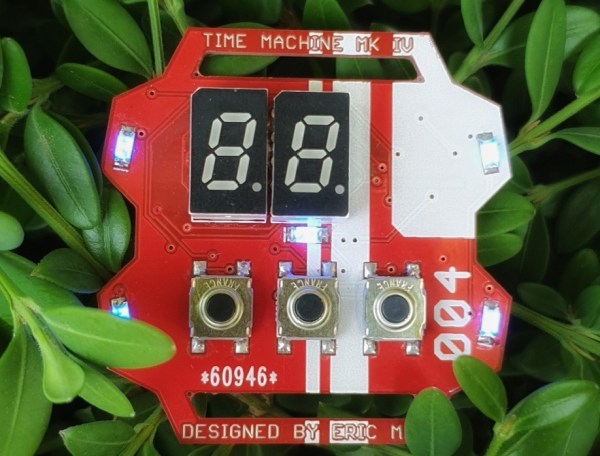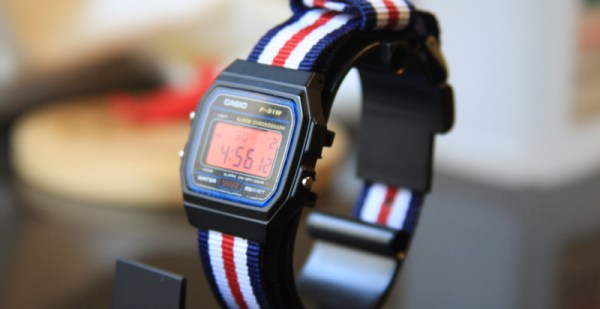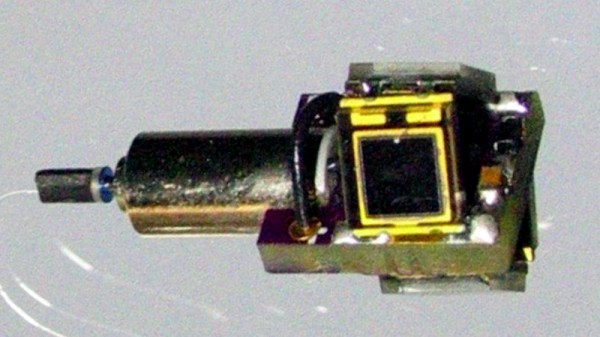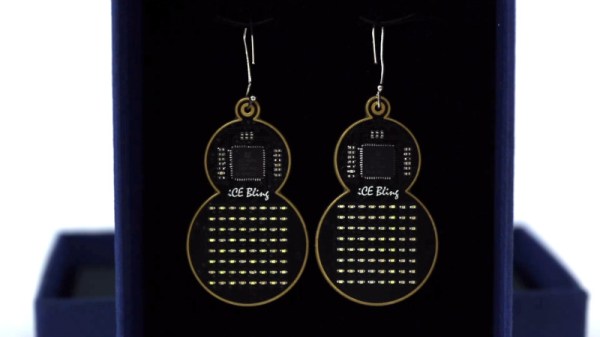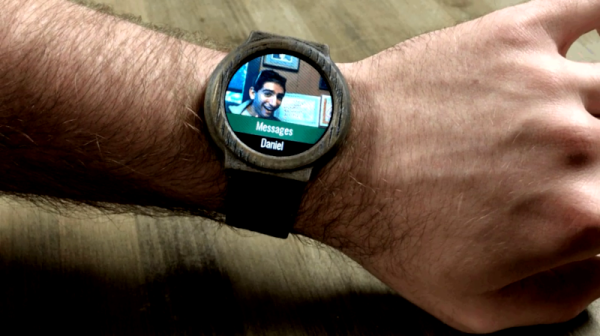Digital watches are a pretty neat idea, and are a great way to experiment with designing and building low-power circuits. That’s what [Eric Min] did with this neat smart watch build. It’s based around an nRF52832 SoC that does all of the heavy lifting, including connecting to a smartphone to get the time when the battery is replaced. It also has a decent quantity of blinky LEDs, which is important on any project of this type.
Wearable Hacks800 Articles
Open Source Headset With Inside-Out Tracking, Video Passthrough
The folks behind the Atmos Extended Reality (XR) headset want to provide improved accessibility with an open ecosystem, and they aim to do it with a WebVR-capable headset design that is self-contained, 3D-printable, and open-sourced. Their immediate goal is to release a development kit, then refine the design for a wider release.
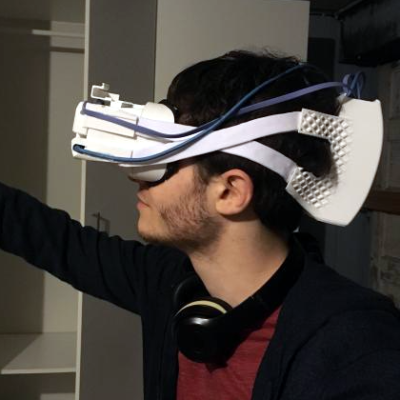
The front of the headset has a camera-based tracking board to provide all the modern goodies like inside-out head and hand tracking as well as the ability to pass through video. The design also provides for a variety of interface methods such as eye tracking and 6 DoF controllers.
With all that, the headset gives users maximum flexibility to experiment with and create different applications while working to keep development simple. A short video showing off the modular design of the HMD and optical assembly is embedded below.
Extended Reality (XR) has emerged as a catch-all term to cover broad combinations of real and virtual elements. On one end of the spectrum are completely virtual elements such as in virtual reality (VR), and towards the other end of the spectrum are things like augmented reality (AR) in which virtual elements are integrated with real ones in varying ratios. With the ability to sense the real world and pass through video from the cameras, developers can choose to integrate as much or as little as they wish.
Terms like XR are a sign that the whole scene is still rapidly changing and it’s fascinating to see how development in this area is still within reach of small developers and individual hackers. The Atmos DK 1 developer kit aims to be released sometime in July, so anyone interested in getting in on the ground floor should read up on how to get involved with the project, which currently points people to their Twitter account (@atmosxr) and invites developers to their Discord server. You can also follow along on their newly published Hackaday.io page.
Continue reading “Open Source Headset With Inside-Out Tracking, Video Passthrough”
Waterproofing The Best Watch Ever Made
The Casio F-91W is probably the most popular wristwatch ever made. It’s been in production forever, it’s been worn by presidents, and according to US Army intelligence it is “the sign of al-Qaeda”. There’s a lot of history in this classic watch. That said, there is exactly one problem with this watch: it’s barely water resistant. [David] thought he had a solution to this problem, and it looks like he may have succeeded. This classic watch is now waterproof, down to 700 meters of depth. If you’re ever 700 meters underwater, you have bigger problems than a watch that isn’t waterproof.
The basic idea of this hack is to replace the air inside the watch with a liquid. This serves two purposes: first, the front glass won’t fog up. Second, liquids are generally incompressible, or at least only slightly compressible. By replacing the air in the watch with mineral oil, the watch is significantly more water resistant.
Filling a watch with mineral oil is done simply by disassembling the watch, submerging it in a dish of mineral oil, and carefully reassembling the watch. Does it work? Don’t know about this watch, but this was done to another classic Casio watch and tested to 1200 psi. That’s a kilometer underwater, and the watch still worked afterward. We’ll take that as a success, although again if you’re ever a kilometer underwater, you have bigger problems than a broken watch.
This Solar-Powered Ear Ring Turns With The Sun
Jewelry making offers many opportunities for the electronics tinkerer, and on these pages we’ve seen some eye-catching creations using LEDs to great effect. They all have the same limitation though, it’s difficult to power something that tiny without a cumbersome battery. In seeking to solve that problem there have been a variety of inventive solutions tried, but they haven’t matched the approach of [Lloyd Konneker] who has turned the whole premise of most electronic jewelry on its head.
Instead of LEDs, the party trick of his earring is an electric motor that makes it spin, and instead of giving out light it takes it in as solar power. The motor is a pager alert device, the solar cells are repurposed photodiodes, and the power is stored in a capacitor until there is enough to drive the motor, at which point a MOSFET is triggered to do the work. It’s all made possible by a Texas Instruments TPS3839 supply voltage supervisor chip, and it works well enough to turn from time to time in bright sunlight. The prototype uses a conventional PCB, but a better version is in the works with a flexible board.
His write-up should be of interest to anyone with a need to learn about micropower circuits, as it goes into significant detail on their tuning and operation. Last year’s Hackaday Prize had an entire section devoted to energy harvesting which is well worth searching the site for, a typical example was this solar powered microcontroller board.
A Stylish Pair Of FPGA Earrings
Sometimes, rather than going the commercialistic route, it can be nice to make a gift for that personal touch. [Mahesh Venkitachalam] had been down this very road before, often stumbling over that common hurdle of getting in too deep and missing the deadline of the occasion entirely. Not eager to repeat the mistake, help was enlisted early, and the iCE bling earrings were born.
The earrings were a gift for [Mahesh]’s wife, and were made in collaboration with friends who helped out with the design. The earrings use a Lattice iCE40UP5k FPGA to control an 8×8 grid of SMD LEDs. This is all achieved without the use of shift registers, with the LEDs all being driven directly from GPIO pins. This led to several challenges, such as routing all the connections and delivering enough current to the LEDs. The final PCB is a 4-layer design, which made it much easier to get all the lines routed effectively. A buffer is used to avoid damaging the FPGA by running too many LEDs at once.
It’s a tidy build, which makes smart choices about component placement and PCB design to produce an attractive end result. LEDs naturally lend themselves to jewelry applications, and we’ve seen some great designs over the years. Video after the break.
Lifelike Dinosaur Emerges From The Plumbing Aisle
Despite the incredible advancements in special effects technology since the film’s release, the dinosaurs in 1993’s Jurassic Park still look just as terrifying today as they did nearly 30 years ago. This has largely been attributed to the fact that the filmmakers wisely decided to use physical models in many of the close-up shots, allowing them to capture the nuances of movement which really helps sell the idea you’re looking at living creatures.
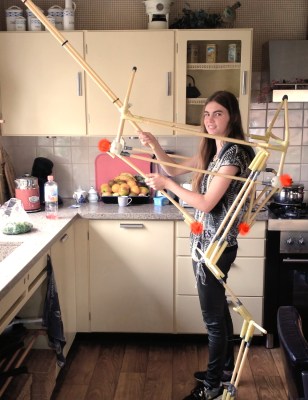 [Esmée Kramer] puts that same principle to work in her incredible articulated dinosaur costume, and by the looks of it, Steven Spielberg could have saved some money if he had his special effects team get their supplies at the Home Depot. Built out of PVC pipes and sheets of foam, her skeletal raptor moves with an unnerving level of realism. In fact, we’re almost relieved to hear she doesn’t currently have plans on skinning the creature; some things are better left to the imagination.
[Esmée Kramer] puts that same principle to work in her incredible articulated dinosaur costume, and by the looks of it, Steven Spielberg could have saved some money if he had his special effects team get their supplies at the Home Depot. Built out of PVC pipes and sheets of foam, her skeletal raptor moves with an unnerving level of realism. In fact, we’re almost relieved to hear she doesn’t currently have plans on skinning the creature; some things are better left to the imagination.
In her write-up on LinkedIn (apparently that’s a thing), [Esmée] explains some of the construction tricks she used to help bring her dinosaur to life, such as heating the pipes and folding them to create rotatable joints. Everything is controlled by way of thin ropes, with all the articulation points of the head mirrored on the “steering wheel” in front of her.
Now to be fair, it takes more than a bundle of PVC pipes to create a convincing dinosaur. Obviously a large part of why this project works so well is the artistry that [Esmée] demonstrates at the controls of her creation. Judging by her performance in the video after the break, we’re going to assume she’s spent a not inconsiderable amount of time stomping around the neighborhood in this contraption to perfect her moves.
In the past we’ve seen the Raspberry Pi used to upgrade life-sized animatronic dinosaurs, but even with the added processing power, those dinos don’t hold a candle to the smooth and organic motion that [Esmée] has achieved here. Just goes to show that sometimes low-tech methods can outperform the latest technological wizardry.
Continue reading “Lifelike Dinosaur Emerges From The Plumbing Aisle”
Scratch Built Smartwatch Looks Pretty Darn Sharp With 3D Printed Case And Round LCD
These days, if you want a smart watch, you’re spoiled for choice. The major smartphone players all have devices on the market, and there’s plenty of third party manufacturers vying for your dollar, too. You might think it’s impossible achieve the same finish with a 3D printer and a reflow oven, but you’re wrong. [Samson March] didn’t quite fancy something off the shelf, though, and instead build an amazing smartwatch of his own.
 The beautiful case is printed in a woodfilled PLA — consisting of 70% plastic and 30% sawdust. This allows it to be sanded and stained for an attractive final product. Printing artifacts actually add to the look here, creating somewhat of a woodgrain effect. There’s a round LCD for a more classical watch look, which displays various graphics and even contact photos for incoming messages. Like most smartwatches on the market, it uses Bluetooth Low Energy for communication, and has a rechargeable lithium battery inside. Estimated battery life is approximately one week, depending on the frequency of use, and the recharging base he fabricated is as beautiful as the watch itself.
The beautiful case is printed in a woodfilled PLA — consisting of 70% plastic and 30% sawdust. This allows it to be sanded and stained for an attractive final product. Printing artifacts actually add to the look here, creating somewhat of a woodgrain effect. There’s a round LCD for a more classical watch look, which displays various graphics and even contact photos for incoming messages. Like most smartwatches on the market, it uses Bluetooth Low Energy for communication, and has a rechargeable lithium battery inside. Estimated battery life is approximately one week, depending on the frequency of use, and the recharging base he fabricated is as beautiful as the watch itself.
It’s a tidy build that shows off [Samson]’s design skills, and files are available on GitHub if you’d like to make your own. Laying out the full design in Fusion 360 prior to the build enabled the watch to be optimized for size constraints, creating an attractive and comfortable piece. With that said, if you’re a fan of a more hardcore electronic aesthetic, perhaps something 8-bit might be more your speed.
[via reddit, thanks to Aliasmk for the tip!]

